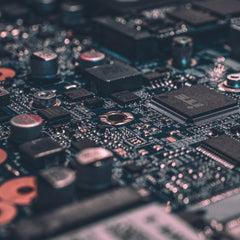Wireless as a reliable and wear-free option for data communication
How do you transfer electrical power and data between a fixed part of a machine or device and its moving or rotating parts, for instance in cranes or wind turbines? Obviously, cables won’t do the job, so this is where the electrical slip ring comes in.
Where is a slip ring used?
Slip rings have been around for ages, and they are used in all industrial branches. They have many names, such as collector rings, rotary joints, electric rotary joints, sliding contacts, rotary electrical contacts etc. Apart from cranes and wind turbines they’re used in industrial plants, mechanical engineering, robots, engines, and medical technology, just to name a few applications.
How slip rings work
As mentioned, slip ring assemblies are used, where you need to transfer power and/or data between stationary and moving parts. In the past such slip ring transmitters have helped solve tricky challenges in designing moving applications, for instance rotary tables.
However, its functional principle requires permanent electrical contact, and as such it has limits regarding data transmission: While you don’t have to worry about short interruptions when it comes to power supply, interruption of data communication in control systems means delayed or lost data packages, leading to errors and often to downtime.
Faulty slip rings? Time to modernize
Another weakness of data transmission via electrical slip ring is the wear and tear of the materials rubbing against each other. This means the slip ring assemblies require regular servicing and replacing, which leads to productivity loss. It gets even worse, if a slip ring suddenly malfunctions. That often leads to production coming to a standstill, resulting in high costs, angry customers and frustrated employees. To avoid that it is crucial to act before accidents happen, and to look into how you can replace slip ring assemblies with reliable and maintenance free data communication.
For instance, plants that previously were equipped with slip ring transmitters for PROFIBUS can be modernized, leading to improved plant availability and production efficiency. For power transmission only, sliding contacts and rotary transmissions continue to be a good option. But they can be complemented nicely with radio solutions. This separation of power supply and data transmission leads to more stable solutions and reduced risk of EMC disturbance.
In most cases, combining slip ring systems for power transfer and radio solutions for data communication is even significantly cheaper than slip ring assemblies that transmit power and ethernet protocols like PROFINET simultaneously. Moreover, this retrofit approach enables step-by-step updating of existing slip ring assemblies without large investment.
Radio is a fast and reliable alternative to rotary transmissions
In addition to the problems coming from wear and tear, rotary electrical contacts reach their limit when a rising number of sensors are integrated into networks and IoT solutions, and when high data rates, failure safety, and real-time communication is required.
Radio transfer is the perfect replacement for data transfer by sliding contacts. Radio technology offers reliable and secure data transfer for all serial Fieldbus protocols, like PROFIBUS or CAN, and also for ethernet communication such as PROFINET. Radio is easily made operational without costly installation and commissioning, and can handle complex networks and long distances. Moreover, Fieldbus converters allow new and older components to run in the same system and to be integrated into one single infrastructure. As a result, with wireless you can build complex networks for Fieldbus communication, with numerous controls and IO modules.
Contrary to other wireless systems like optical data transceivers, inductive systems or optical fibers, radio communication is flexible and absolutely wear-free. No maintenance means maximum availability of machines and production systems.
Which radio solution for replacing slip rings?
There are huge differences between the radio solutions available, and therefore large variations in transmission security and reliability. With DATAEAGLE Schildknecht offers a patented technology combining fast and easy plug & play installation with the highest degree of transmission stability. This eliminates Fieldbus errors coming from disturbances in data transmission, because data packets are analyzed, pre-processed and prioritized before being transmitted. Due to short-time storage of commands and configurable filtering time, short-time radio interference can be bypassed. This makes the data connection stable and reliable, even under harsh surrounding conditions.
Find the ideal solution for your application
Radio data systems with stabilized transmission are reliable, durable, maintenance-free, with secure communication and robustness against transmission errors. This makes them ideally suited for industrial machines and plants. In addition, the patented DATAEAGLE product family offers maximum flexibility and easy plug & play installation. This enables you to swiftly find the ideal wireless data transfer solution for your specific use case.
Does your application have special requirements? We’re looking forward to finding the ideal solution together with you!
Please reach out to arrange a meeting about your project – free and noncommittal
At a glance: Replacing slip rings with wireless
- Ready immediately due to plug & play installation, even in complex networks and multi point connections
- Stabilized radio paths with DATAEAGLE enhance security and reliability, due to pre-processed data and prioritized transmission
- Maximum system availability, radio solutions are wear-free and maintenance-free
- Ideal for modernization and retrofit, older or faulty rotary transmissions are quickly and easily replaced by radio modules. This allows for step-by-step modernization without steep entry costs.







